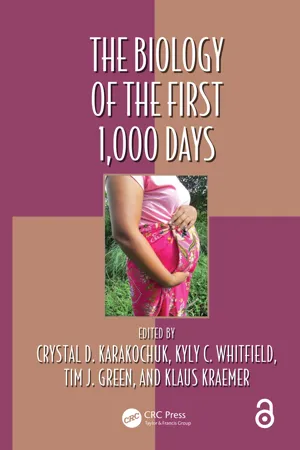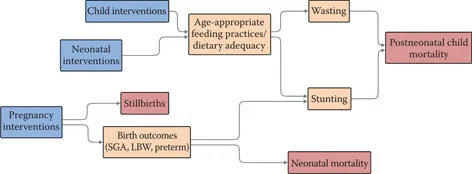
eBook - ePub
The Biology of the First 1,000 Days
- 494 pages
- English
- ePUB (mobile friendly)
- Available on iOS & Android
eBook - ePub
The Biology of the First 1,000 Days
About this book
The first 1, 000 days, from conception to two years of age, is a critical period of growth and development. Exposures to dietary, environmental, hormonal, and other stressors during this window have been associated with an increased risk of poor health outcomes, some of which are irreversible. The book addresses this crucial interval of early life across biological disciplines, linking concepts related to all biological fields to outcomes during the first 1, 000 days (e.g. fetal growth and pregnancy outcomes) and beyond (e.g. gut microbiome and cardiovascular disease later in life). The strength of this book lies in its cross-disciplinary nature.
Frequently asked questions
Yes, you can cancel anytime from the Subscription tab in your account settings on the Perlego website. Your subscription will stay active until the end of your current billing period. Learn how to cancel your subscription.
No, books cannot be downloaded as external files, such as PDFs, for use outside of Perlego. However, you can download books within the Perlego app for offline reading on mobile or tablet. Learn more here.
Perlego offers two plans: Essential and Complete
- Essential is ideal for learners and professionals who enjoy exploring a wide range of subjects. Access the Essential Library with 800,000+ trusted titles and best-sellers across business, personal growth, and the humanities. Includes unlimited reading time and Standard Read Aloud voice.
- Complete: Perfect for advanced learners and researchers needing full, unrestricted access. Unlock 1.4M+ books across hundreds of subjects, including academic and specialized titles. The Complete Plan also includes advanced features like Premium Read Aloud and Research Assistant.
We are an online textbook subscription service, where you can get access to an entire online library for less than the price of a single book per month. With over 1 million books across 1000+ topics, we’ve got you covered! Learn more here.
Look out for the read-aloud symbol on your next book to see if you can listen to it. The read-aloud tool reads text aloud for you, highlighting the text as it is being read. You can pause it, speed it up and slow it down. Learn more here.
Yes! You can use the Perlego app on both iOS or Android devices to read anytime, anywhere — even offline. Perfect for commutes or when you’re on the go.
Please note we cannot support devices running on iOS 13 and Android 7 or earlier. Learn more about using the app.
Please note we cannot support devices running on iOS 13 and Android 7 or earlier. Learn more about using the app.
Yes, you can access The Biology of the First 1,000 Days by Crystal D Karakochuk, Kyly C. Whitfield, Tim J Green, Klaus Kraemer, Crystal D Karakochuk,Kyly C. Whitfield,Tim J Green,Klaus Kraemer in PDF and/or ePUB format, as well as other popular books in Medicine & Biology. We have over one million books available in our catalogue for you to explore.
Information
Section XEffective Interventions during the First 1,000 Days
24Effectiveness of Nutrition-Specific Interventions in Pregnancy and Early Childhood
Rebecca Heidkamp, Adrienne Clermont, and Robert E. Black
Introduction
Maternal Interventions
Micronutrient Interventions
Iron Folic Acid Supplementation
Multiple Micronutrient Supplementation
Food Fortification
Calcium Supplementation
Balanced Protein-Energy Supplementation
Intrapartum/Neonatal Interventions
Early Initiation of Breastfeeding
Neonatal Vitamin A Supplementation
Delay of Umbilical Cord Clamping
Child Interventions
Breastfeeding Promotion
Promotion of Age-Appropriate Complementary Feeding and Provision of Supplemental Food
Education Only
Provision of Supplement with Energy and Micronutrients
Micronutrient Supplementation
Vitamin A Supplementation
Preventive Zinc Supplementation
Multiple Micronutrient Supplementation
Management of Severe Acute Malnutrition
Management of Moderate Acute Malnutrition
Conclusion
References
Introduction
The 2013 Lancet series on Maternal and Child Nutrition included a comprehensive review of interventions that affect the nutritional status of women and young children in low- and middle-income countries (LMICs). The series’s authors estimated that if 10 known effective interventions were scaled up to 90% coverage, we could eliminate 15% of under-5 deaths and reduce stunting by 21% globally [1]. The objective of this chapter is to review and update this work with the latest research evidence on the effectiveness of these 10 and other nutrition-specific interventions to prevent poor growth and improve child survival during the crucial first 1,000 days of life. We will focus primarily on interventions delivered at scale through the health system. Outcomes of interest include birth outcomes (preterm, small for gestational age, low birth weight), risk of subsequent growth faltering (stunting, wasting), and mortality during the first 5 years of life. We will not consider effects on anemia, developmental outcomes, or overweight/obesity risk, nor will we address the broader range of nutrition-sensitive interventions that affect more distal determinants of nutritional status (including food production systems, water and sanitation, and household socioeconomic status). Others have provided comprehensive reviews of these important strategies [2].
Interventions are presented by the continuum of care from pregnancy through early childhood (Figure 24.1). We will describe each intervention, identify the general biological mechanism through which it is understood to have an effect, and review the latest evidence on effectiveness.

Figure 24.1A conceptual map of interventions, risk factors, and outcomes.
Maternal Interventions
Interventions to improve maternal nutritional status before and during pregnancy can have long-lasting effects on child growth and survival. Several interventions delivered to women before or during pregnancy affect neonatal outcomes (Table 24.1), including the risk of preterm and small for gestational age (SGA) births, as well as neonatal mortality [3]. Babies who are born preterm or SGA are at higher risk of stunting [4] and mortality [5] in early childhood (Table 24.2). Infants in South Asia are at a higher risk of being wasted from very soon after birth than children in other regions [6].
Table 24.1Maternal Intervention Effects
Intervention | Outcome of Interest | Effect Size (95% CI) |
|---|---|---|
Periconceptual folic acid supplementation | Neural tube defects | RR: 0.31 (0.17, 0.58) |
| Iron supplementation in pregnancy | Iron-deficiency anemia | RR: 0.33 (0.16,0.69) |
Low birth weight | RR: 0.84 (0.69, 1.03) | |
| Multiple micronutrient supplementationa | Low birth weight | RR: 0.88 (0.85, 0.91) |
SGA | RR: 0.90 (0.83, 0.97) | |
Stillbirth | RR: 0.91 (0.85, 0.98) | |
Calcium supplementation in pregnancy | Preterm births | RR: 0.76 (0.60, 0.97) |
| Balanced energy-protein supplementation in pregnancy | SGA | RR: 0.79 (0.69, 0.90) |
Stillbirth | RR: 0.60 (0.39, 0.94) | |
Birth weight | MD: +40.96 g (4.66, 77.26) |
Note: RR, relative risk; MD, mean difference.
a Effects are compared to iron or iron-folic acid supplementation.
Table 24.2Impact of Birth Outcomes on Stunting and Mortality
Birth Outcome Group | Relative Risk of Stunting at 12–60 Months (95% CI) | Relative Risk of Neonatal Mortality (95% CI) | Relative Risk of Postneonatal Mortality (95% CI) |
|---|---|---|---|
Term, not SGA | 1 (reference group) | 1 (reference group) | 1 (reference group) |
Term, SGA | 2.43 (2.22, 2.66) | 3.06 (2.21, 4.23) | 2.20 (1.57, 3.08) |
Preterm, not SGA | 1.93 (1.71, 2.18) | 9.44 (5.08, 17.55)... |
Table of contents
- Cover
- Half Title Page
- Series Page
- Title Page
- Copyright Page
- Contents
- Series Preface
- Preface
- Acknowledgments
- Editors
- Author
- Section I Introduction
- Section II What Is Normal Growth?
- Section III Nutritional Requirements in the Life Stages
- Section IV Endocrinology in the Regulation of Growth
- Section V Adverse Pregnancy and Birth Outcomes (Pathophysiology and Consequences)
- Section VI Pathophysiology and Nutrition Requirements in Child Malnutrition
- Section VII Body Composition
- Section VIII The Gut Microbiome
- Section IX Effects of Early Life Exposures and Nutrition
- Section X Effective Interventions during the First 1,000 Days
- Section XI Before and Beyond the 1,000 Days
- Section XII Discovery Research
- Index